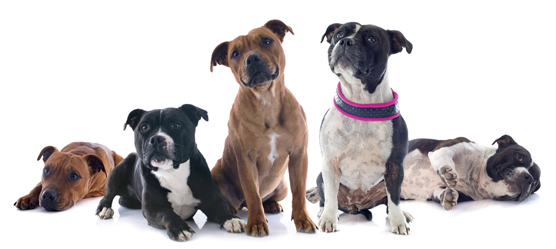 © cynoclub / Shutterstock.com
© cynoclub / Shutterstock.comFive-Minute Health Check for Your Pit Bull
Pit Bulls aren’t sickly dogs by any means, but you do need to keep an eye out for certain problems. You can keep your lovable Pit Bull in good health by checking the areas in the following list and addressing any problems that present themselves:
-
Mouth: Red, bleeding, swollen, or discolored gums; loose or dirty teeth; ulcers of tongue or gums; bad breath
-
Eyes: Squinting, discharge, cloudiness, discolored whites, unequal or unresponsive pupils
-
Ears: Bad odor, redness, debris, crusted tips, head shaking or tilting, ear scratching
-
Nose: Thick or colored discharge; crusted top
-
Feet: Abrasions, split nails, swollen or misaligned toes
-
Anal region: Redness, swelling, discharge; also scooting or licking the area
-
Skin: Parasites, hair loss, crusts, red spots, lumps, sores
-
General: Lameness, incoordination, asymmetry of muscles, weight change, swellings, mammary or testicular changes, discharge from penis or vulva, swollen abdomen, coughing, gagging, lethargy, increased aggression, black or bloody stool; changes in urine or urination, appetite or water consumption
Medical Basics and Emergency First Aid for Your Pit Bull
You want to keep your Pit Bull in the pink of health, and you want to be prepared to care for your dog in a canine emergency. Your basic, essential tools are phone numbers you can access at any time — your dog’s veterinarian and the animal emergency clinic.
The following list shows parameters for a healthy Pit Bull:
-
Respiration: 10-30 breaths per minute at rest
-
Pulse: 60-120 beats per minute at rest
-
Temperature: 101.5 to 102.5 degrees F
-
Capillary refill time: Less than 2 seconds
-
Gum color: Pink (not white, red, bluish, yellowish, or with tiny red spots)
-
Hydration: Skin should pop back into position within 3 seconds of being lifted.
If your dog isn’t breathing, follow these steps to give your pooch artificial respiration:
-
Open and clear dog’s mouth and pull the tongue forward.
-
Seal you mouth over the dog’s mouth and nose and blow for two seconds. Repeat every four seconds.
To give your dog CPR if his or her heart stops, follow these steps:
-
Place one hand on top of the other on the dog’s left chest two inches up from and behind the elbow.
-
Press and release quickly about 100 times per minute.
-
Give two breaths into the nose every 15 compressions.
For other canine emergencies, use the information in the following list, and in any emergency, get your pet to a vet as soon as possible:
-
Obstructions: Wrap your hands around the abdomen behind the rib cage and compress briskly. If the dog is unconscious, pull its tongue forward and explore the throat.
-
Drowning: Hold the dog upside down so that water can run out; then give artificial respiration
-
Bleeding: Cover the wound with clean dressing and apply pressure. Elevate the wound site and apply a cold pack.
-
Heat stroke: Wet the dog and place it in front of a fan. (Do not plunge the dog into ice water.) Offer water for drinking.
-
Bloat: Go to an emergency veterinarian immediately. No home treatment available.
-
Antifreeze ingestion: Go to an emergency veterinarian immediately. No home treatment available.
-
Rodent poisoning: Go to an emergency veterinarian immediately. No home treatment available.

